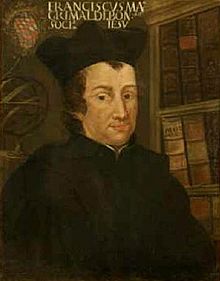Francesco Maria Grimaldi facts for kids
Quick facts for kids
The Rev. Dr.
Francesco Maria Grimaldi
|
|
|---|---|
 |
|
| Born | 2 April 1618 |
| Died | 28 August 1663 (aged 45) |
| Nationality | Italian |
| Other names |
|
| Known for | free fall, diffraction |
| Scientific career | |
| Fields | Mathematics, Physics |
Francesco Maria Grimaldi (born April 2, 1618 – died December 28, 1663) was an Italian Jesuit priest, mathematician, and physicist. He taught at the Jesuit college in Bologna, the city where he was born. Grimaldi made important discoveries about how objects fall and how light behaves.
Contents
Grimaldi's Scientific Work
Between 1640 and 1650, Grimaldi worked with another scientist named Giovanni Riccioli. They studied how objects fall, which is called free fall. They confirmed that the distance an object falls is related to the square of the time it takes. This means if an object falls for twice as long, it falls four times the distance.
Measuring Gravity
Grimaldi and Riccioli also tried to measure the gravity on Earth. Gravity is the force that pulls things towards the ground. They did this by watching how a very accurate pendulum swung back and forth. Their work helped scientists understand more about this important force.
Mapping the Moon
In the field of astronomy, which is the study of space, Grimaldi built special tools. He used these tools to measure the height of mountains on the Moon and even the height of clouds in Earth's sky. He also drew a very detailed map of the Moon. This map is called a selenograph. Riccioli published this map, and today, a copy of it is at the entrance of the National Air and Space Museum in Washington D.C.
Discovering Light Diffraction
Grimaldi was the first person to carefully observe and describe something called diffraction of light. Diffraction happens when light bends as it passes around an obstacle or through a small opening. He even created the word 'diffraction'.
In his book, Physico-Mathesis de Lumine, Coloribus et Iride (published in 1665), Grimaldi explained his ideas. He suggested that sunlight is made up of different colors that can be separated and then put back together.
Through his experiments, Grimaldi showed that light does not always travel in a perfectly straight line. For example, when light passed through a small hole, it spread out like a cone, instead of just making a sharp spot. Later scientists, like the Dutch mathematician Christiaan Huygens, used Grimaldi's work. It helped them understand that light might behave like a wave, not just a stream of tiny particles. Grimaldi also found what are now called diffraction bands, which are patterns of light and dark created by diffraction.
Lunar Crater Grimaldi
A large crater on the Moon is named Grimaldi in his honor.
See also
 In Spanish: Francesco Maria Grimaldi para niños
In Spanish: Francesco Maria Grimaldi para niños
- List of Jesuit scientists
- List of Roman Catholic scientist-clerics

